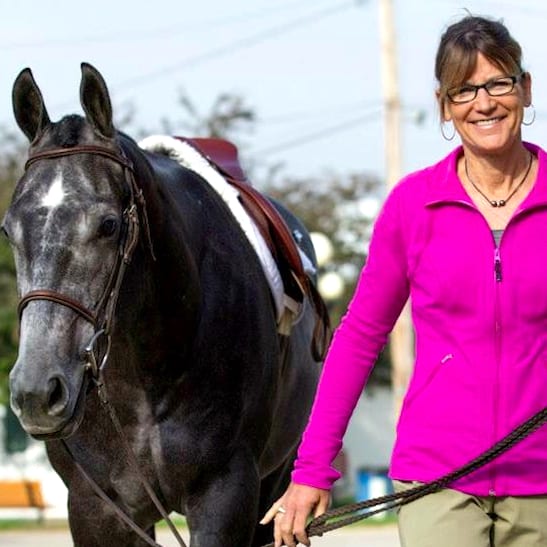A recent post has raised the question of how to coach uncoachable riding students. The quote originally posted by University of Alabama softball coach, Patrick Murphy stated, “Uncoachable kids become unemployable adults. Let your kid get used to somebody being tough on them! That’s life, get over it.”
It is a strong statement, one that raises more than eyebrows and indeed one that most horse trainers have faced if they have been in the business for any length of time. We hear it all the time, kids are different today, they are busier, they don’t know how to work and they don’t have time, blah, blah and blah. But kids today are every bit as coachable as the kids were twenty years ago – they just have to be motivated.
Coachability refers to a person’s mental attitude towards the game. People who accept coaching easily often display a good bit of humility, they understand that mistakes are learning experiences, trust their coach to lead them to better performance and are secure in their sense of self.
Uncoachable students avoid responsibility. They usually assess their skills as being greater than they are and get extremely defensive when receiving feedback that is not positive. They are often adept at letting the coach know they disagree with the coach’s feedback even if only through their posture, facial expression or lack of action.
Fear of failure, fear of making mistakes, fear of feeling awkward or embarrassed or fear of another person’s negative appraisal can all lead to defensive difficult students. According to horse show judge, blogger and Sports Psychologist Karen Waite, “defensive kids (or adults) typically are trying to protect themselves from something. It’s often related to self esteem, or fear of not being good enough, which when showing horses at almost any level can be an issue.”
Many riders today are accused of having affluenza (a combination of the words influenza and affluent) – a condition that results in feelings of entitlement from those with financial privilege. Whatever the reason, the uncoachable rider is going to blame the trainer, the horse or the dumb judge for their lack of success. Instead of taking responsibility for their ride, they will carefully and often skillfully deflect it – sometimes with an air of superiority to boot.
Regardless of the cause, the end result is an indifferent attitude toward challenging situations, learning and obstacles that lay in the path to reaching goals. And while it can be helpful to determine why a person cannot take responsibility for their advancement, it is not necessary to fully understand the why in order to help the student.
It is, however, imperative to understand that defensive attitudes come from a place of weakness – not a place of strength. As coaches, it is our job to tear down those defenses and build grit, perseverance and real self-confidence – the kind that comes from knowledge, skill and a deep understanding of riding and horses.
Preparing a response to defensive students also causes coaches to face some hard truths. Often we have to consider some of our habits that may make it more difficult for the student to let his or her defenses down. Here are five things to consider before putting a plan in motion.
- Determine the length you are willing to go to keep a client. In the heat of the battle it is often difficult to see the harm a customer’s negative attitude can have on your entire business. But often when we offer to help toxic clients find another trainer, they either shape up or leave and your business picks up – considerably! You have to be willing to lose a client to truly help the uber defensive. Early in my career, I turned away my first affluent client because the daughter intentionally ignored and went against my instruction. While teaching jumping, the disregard for my authority put her in personal danger, a transgression I was unwilling to accept. I gratefully declined their business yet they have always cheered and supported my career.
- Determine the non-negotiables in your business. These could be things such as the horses’ health always comes first (obviously), every rider picks up after themselves, every rider saddles their own horse, every rider has to do time on the longe line or that the horses are never to blame. Make everyone live under the same philosophy – your moral code. You will see how to use this to your advantage later…
- Get into your riders’ heads. Great horse trainers are not great because they force every horse to fit into their mold. Great horse trainers are great because they figure out how to respond to the various and different personalities of the horses they train. One horse takes a spur and another simply does not. Use this talent with your riders – each rider/student comes at learning from a different place. Some learn best with visual aids, some learn best with verbal direction. Determine the kind of learner your rider is.
- Lead by example. Your behavior will shape your students’ behavior. Be a role model for grit, happiness and accepting responsibility for what happens in your barn and in your world. Do not complain about judges, horses’ behavior or place blame on outside factors. Accept responsibility for your actions and others around you will do the same.
- Coaching is a process. Don’t think of coaching as something that you do to someone, instead think of it as something you do with another rider. Teaching is interactive – you do not simply teach people to ride, you develop riders – it is always ongoing.
Developing methods to deal with difficult students improves with experience. Horse trainers are generally most gifted at riding horses. The ability to train horses and the ability to train people to ride horses are neither mutually exclusive nor are they automatically accompanying capabilities. While many trainers are truly gifted on a horse’s back, their ability to train people to ride is a skill – one that strengthens with time and experience.
There are many ways to work toward breaking down a rider’s defenses. It takes work and will not happen over night – like training horses, it takes time. It is a process. Keep in mind that these students do not accept criticism because they lack self-esteem. They fear looking like a fool and desperately want to be accepted.
- Build trust. Students must be able to trust you. Be sincere; speak the truth without being brutal. Be competent and reliable, say what you mean and do what you say you will do. Students must believe that you truly care about them.
- Do not avoid conversations. But do consider the appropriate time and place for serious conversations. While it is important to hold riders accountable, hold sensitive exchanges in private, maintain a friendly even tone regardless of how defensive your rider gets. Be honest; do not sugar coat or gloss over the truth – but stick to the facts in clear precise statements, not generalizations that avoid potential conflict.
- Start with a positive statement. Before criticizing, tell the rider what they did well. It softens the criticism and will make it easier for the student to accept negative feedback. For example, “your stop and 360 was beautiful, however when your turned to back your horse you were out of position and your horse did not understand your cue.“
- Discuss both positive and negative impact of rider’s decisions. Remind the rider/student that life and winners are determined by split second decisions. You are teaching good decision-making on horseback. Make sure the communication is two-way communication. Do not monopolize the conversation. Allow the student to tell you their perception of the situation and what caused them to make the decision they made.
- Establish goals. Use your two-way conversation to establish goals. This engages the defensive student in a positive frame of mind. Smaller goals can be used to assess progress on the road to bigger goals. This exercise may help you find what spurs your student into action. Create a reachable vision towards problems as well as the steps necessary to reach the goal.
- Encourage mistakes. Riders who are afraid of making mistakes, afraid to be embarrassed in front of someone or express an indifferent attitude are missing out on the greatest opportunities. A rider can never learn how to handle a horse taking the wrong lead if the horse never takes the wrong lead. Put the rider on another horse, one that will make a mistake and let the horse be the teacher. Horses are the best teachers and the best humblers. They are also the greatest confidence builders – when the rider communicates properly the horse responds and the pair work harmoniously.
- Promote responsibility then reward good behavior. After a difficult student has a light-bulb moment, reward the student by helping them with something that they feel is a “chore.” Go back to your list of non-negotiables. If there is something on your list that you can assist with, this is a perfect time for it. Assisting the student shows appreciation, encourages teamwork and lets the individual know you recognized their efforts. Karen suggests sharing something special with the student to celebrate their efforts. Whether it is ice cream, a quiet moment while wrapping legs or a high five as they exit the arena, recognizing their efforts publicly builds confidence and tears down defenses.
- Don’t hold onto past behavior. Allow the student to move beyond their past. Don’t bring up past indiscretions that could embarrass or raise defenses. Help the student let go of the past by designing and building new behavior and reactions to old situations. Reward new improved behavior.
- Balance tough coaching with consideration. Coaches that are continually too tough can become unapproachable. Your authority is based on your knowledge and your capacity to work with various skill levels. Knowing when to push and when to pull back is a critical skill. Employ every method available to develop foresight to know the difference between pushing, bullying, placating and rewarding.
- Don’t micromanage. Create a rider not a robot. Some people think that my-way-or-the-highway is the only way to make a champion. Rarely is this an effective method. Riders enter the arena and must be able to handle whatever little old thing comes their way. A trainers’ job is to prepare the rider to handle things without the trainer. Get out of their way. Allow the rider to figure things out on his or her own, give them an opportunity to prove you wrong then celebrate their breakthrough moments.
Only you can determine how much effort you will put into someone who is unwilling to accept help. And while the uncoachable rider is still a paying client, you want to create a winning team and may feel like you have failed the rider who is unwilling to be helped. If the person is truly unwilling to accept responsibility you will have to decide whether or not they belong on your team. Ultimately, it is your decision who you choose to work for.
Remember the overly defensive rider comes from a place of weakness, not strength. And unfortunately, this puts them in a position where they cannot learn. They are emotionally wounded and you may have to dig deep to find a way through their defense mechanisms. It is the coach’s job is to facilitate the learning but in the end, the student is responsible for the learning.
You are teaching humility, trust and good decision-making. Each of us must learn to look at what we have done wrong. Mistakes build the foundation of all our learning and developing as a rider and a person. Liken your journey with a defensive student to the natural progression of a person’s character – yours and the students.









